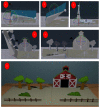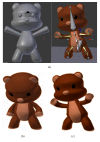Novel Virtual Environment for Alternative Treatment of Children with Cerebral Palsy
- PMID: 27403154
- PMCID: PMC4923569
- DOI: 10.1155/2016/8984379
Novel Virtual Environment for Alternative Treatment of Children with Cerebral Palsy
Abstract
Cerebral palsy is a severe condition usually caused by decreased brain oxygenation during pregnancy, at birth or soon after birth. Conventional treatments for cerebral palsy are often tiresome and expensive, leading patients to quit treatment. In this paper, we describe a virtual environment for patients to engage in a playful therapeutic game for neuropsychomotor rehabilitation, based on the experience of the occupational therapy program of the Nucleus for Integrated Medical Assistance (NAMI) at the University of Fortaleza, Brazil. Integration between patient and virtual environment occurs through the hand motion sensor "Leap Motion," plus the electroencephalographic sensor "MindWave," responsible for measuring attention levels during task execution. To evaluate the virtual environment, eight clinical experts on cerebral palsy were subjected to a questionnaire regarding the potential of the experimental virtual environment to promote cognitive and motor rehabilitation, as well as the potential of the treatment to enhance risks and/or negatively influence the patient's development. Based on the very positive appraisal of the experts, we propose that the experimental virtual environment is a promising alternative tool for the rehabilitation of children with cerebral palsy.
Figures










Similar articles
-
Kinect Xbox 360 as a therapeutic modality for children with cerebral palsy in a school environment: a preliminary study.NeuroRehabilitation. 2013;33(4):513-21. doi: 10.3233/NRE-131001. NeuroRehabilitation. 2013. PMID: 24018364
-
Role of virtual reality for cerebral palsy management.J Child Neurol. 2014 Aug;29(8):1119-24. doi: 10.1177/0883073814533007. Epub 2014 May 5. J Child Neurol. 2014. PMID: 24799367 Review.
-
Motor performance of individuals with cerebral palsy in a virtual game using a mobile phone.Disabil Rehabil Assist Technol. 2018 Aug;13(6):609-613. doi: 10.1080/17483107.2017.1392620. Epub 2017 Nov 1. Disabil Rehabil Assist Technol. 2018. PMID: 29092683
-
Usability testing of a developed assistive robotic system with virtual assistance for individuals with cerebral palsy: a case study.Disabil Rehabil Assist Technol. 2018 Aug;13(6):517-522. doi: 10.1080/17483107.2017.1344884. Epub 2017 Jul 4. Disabil Rehabil Assist Technol. 2018. PMID: 28673115
-
Robot-assisted and computer-enhanced therapies for children with cerebral palsy: current state and clinical implementation.Semin Pediatr Neurol. 2013 Jun;20(2):139-45. doi: 10.1016/j.spen.2013.06.006. Semin Pediatr Neurol. 2013. PMID: 23948688 Review.
Cited by
-
Advancing Brain-Computer Interface Applications for Severely Disabled Children Through a Multidisciplinary National Network: Summary of the Inaugural Pediatric BCI Canada Meeting.Front Hum Neurosci. 2020 Dec 3;14:593883. doi: 10.3389/fnhum.2020.593883. eCollection 2020. Front Hum Neurosci. 2020. PMID: 33343318 Free PMC article.
-
An Innovative Approach for Online Neuroanatomy and Neurorrehabilitation Teaching Based on 3D Virtual Anatomical Models Using Leap Motion Controller During COVID-19 Pandemic.Front Psychol. 2021 Jun 28;12:590196. doi: 10.3389/fpsyg.2021.590196. eCollection 2021. Front Psychol. 2021. PMID: 34262499 Free PMC article.
-
Validation of the Kinematic Assessment Protocol Used in the Technology-Supported Neurorehabilitation System, Rehabilitation Technologies for Hand and Arm (R3THA™), in Children and Teenagers with Cerebral Palsy.Sensors (Basel). 2024 Aug 2;24(15):5013. doi: 10.3390/s24155013. Sensors (Basel). 2024. PMID: 39124059 Free PMC article.
-
Overground Walking in a Fully Immersive Virtual Reality: A Comprehensive Study on the Effects on Full-Body Walking Biomechanics.Front Bioeng Biotechnol. 2021 Dec 3;9:780314. doi: 10.3389/fbioe.2021.780314. eCollection 2021. Front Bioeng Biotechnol. 2021. PMID: 34957075 Free PMC article.
-
Virtual Reality-Based Exercise with Exergames as Medicine in Different Contexts: A Short Review.Clin Pract Epidemiol Ment Health. 2019 Jan 31;15:15-20. doi: 10.2174/1745017901915010015. eCollection 2019. Clin Pract Epidemiol Ment Health. 2019. PMID: 30972138 Free PMC article. Review.
References
-
- Latta J. N., Oberg D. J. A conceptual virtual reality model. IEEE Computer Graphics & Applications. 1994;14(1):23–29. doi: 10.1109/38.250915. - DOI
-
- Burdea G., Coiffet P. Virtual Reality Technology. 2nd. New York, NY, USA: Wiley-IEEE Press; 2003.
-
- Tori R., Kirner C., Siscoutto R. Fundamentos e tecnologia de realidade virtual e aumentada. Proceedings of the 8th Symposium on Virtual Reality; May 2006; Belém, Brazil. pp. 2–21.
-
- de la Cuerda R. C., Muñoz-Hellín E., Alguacil-Diego I. M., Molina-Rueda F. Telerehabilitation and neurology. Revista de Neurologia. 2010;51(1):49–56. - PubMed
MeSH terms
LinkOut - more resources
Full Text Sources
Other Literature Sources
Medical

